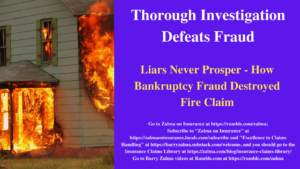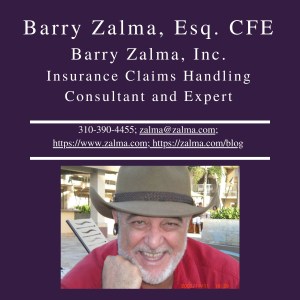Thorough Investigation Defeats Fraud


Over the last 54 years in the insurance business I have faced people with insurance claims who had, shortly before their claim, sworn to a bankruptcy court that they only had $500 in jewelry and minimal amounts of personal property to avoid losing their assets to their creditors. One even testified that he lied on his bankruptcy proceedings because he didn’t want his creditors to get his airplane. (He, by the way, went to jail for bankruptcy fraud and recovered nothing on his insurance claim). It is hard to answer when a person is asked which under oath statement is true: the bankruptcy filing or the claim. I always insist that a thorough investigation requires a review of bankruptcy filings.
In Rick Merechka v. Vigilant Insurance Company, a foreign corporation; Rick Merechka v. Vigilant Insurance Company, a foreign corporation, Nos. 19-3427, 19-3497, United States Court of Appeals, Eighth Circuit (February 16, 2022) the Eighth Circuit was faced with just such a situation and assumed that the statement made in the bankruptcy filing was true.
FACTUAL BACKGROUND
After Rick Merechka’s home burned to the ground, he sought benefits under his homeowner’s policy. Following an investigation, his insurer, Vigilant Insurance Company, denied the claim because it concluded that he had lied about the amount of personal property he owned. Merechka sought payment of his claim in full, and Vigilant requested reimbursement for the money it had already paid to his mortgage lender. On cross-motions for summary judgment, the district court concluded that neither side owed the other anything.
During its investigation, Vigilant discovered that Merechka had filed for bankruptcy just four-and-a-half years earlier. According to his bankruptcy petition, he had around $9,000 in personal property-well short of the more than $600,000 (or $325,825, according to a third-party appraiser) that he reported to Vigilant.
Merechka had an answer. He assured Vigilant that he had acquired nearly all of his personal property after the bankruptcy using several sources of income: $700 a week he received for working for his brother, a $1,300 monthly social-security payment, and periodic payments from an investment account.
The numbers did not add up. Following the denial, Merechka sued and Vigilant filed a counterclaim of its own. Merechka sought the more than $1 million he thought he was owed under the policy, and Vigilant demanded reimbursement for the nearly $400,000 it had paid to Merechka’s mortgage lender as required by the standard mortgage clause.
Applying Arkansas law, the district court, in a Solomon-like decision, determined that neither side owed anything. Both sides appealed.
DISCUSSION
Given that Merechka continues to stick by the much lower figure he swore to in his bankruptcy petition, the district court reasoned that no reasonable juror could possibly conclude that Merechka did anything other than lie on his proof-of-loss forms, which reported at least $325,825.67 in personal property just a few years later.
The concealment-or-fraud provision, which “void[ed]” the policy if Merechka “intentionally concealed or misrepresented any material fact relating to this policy before or after the loss,” is the key to the resolution of the claim. The district court concluded that the evidence pointed in only one direction: Merechka intentionally lied about the amount of personal property he owned, a material fact that voided the policy.
To accumulate more than $325,000 in personal property over a four-and-a-half-year period, Merechka’s spending would have needed to exceed an average of $6,000 per month. The problem for him is obvious: he made only $4,300 per month and had a $1,750-a-month mortgage payment and other bills. Even if he spent every remaining penny assembling a collection of personal property, it would not have been enough.
There is more. Despite the sheer number of purchases he would have needed to make in the four-and-a-half years before the fire, Merechka has no proof-not even a single receipt or canceled check-for any of them. To be sure, as Merechka points out, photographs show the home with various items of personal property inside. And witnesses identified some of it, including televisions and furniture. But it is not clear how much he purchased after the bankruptcy, let alone how it adds up to at least $325,000 in value. At best, it just invites the jury to speculate.
No reasonable juror could believe that Merechka acquired so much property in such a short time on his modest income. The only “reasonable inference[],” in other words, is that Merechka lied. Merechka’s lies were obviously intentional. For the concealment-or-fraud provision to apply, the “covered person” must have “intentionally concealed or misrepresented” a fact.
The circumstances here show that Merechka intentionally overstated the value of his personal property to get a bigger payout from Vigilant. The only reasonable inference from the record before the court was that he must have intentionally misrepresented its value.
There was no genuine issue of material fact about the materiality of Merechka’s misrepresentations. Under the concealment-or-fraud provision, the lies must not only be intentional, they must also be about “a material fact.” The Eighth Circuit agreed with the district court that there was “little doubt” that Merechka’s misrepresentations touched on information material to Vigilant’s decision.
An accurate inventory of the property destroyed was not just relevant, it was necessary for Vigilant to make a coverage determination.
Under the concealment-or-fraud provision, Merechka had an obligation to respond truthfully.
Arkansas’s valued-policy law does not help Merechka either. Arkansas has a statute that allows policyholders to make “a liquidated demand . . . for the full amount stated in the property insurance policy” after “a total loss by fire.” Ark. Code Ann. § 23-88-101(a)(1). Deemed a part of every homeowner’s policy, the law prevents insurers from receiving premiums on overvaluations, and thereafter repudiating their contracts as soon as it is in their interest to do so. The problem for Merechka is that the valued-policy law does not shield fraud. The beneficent effects of the statutory valued-policy provision cannot be converted into a camouflage to conceal and protect fraud and crime.
Once Merechka lied on his proof-of-loss forms, it voided the policy altogether, making this a case about whether there was any insurance at all, rather than the amount of the insurance. Relying on the valued-policy law, he further argues that he is entitled to a full payout for his dwelling even if he lied about its contents. The assumption underlying his argument is that the insurance policy is divisible: one policy for the dwelling and a separate one for its contents.
Vigilant filed a counterclaim to recover the $380,001 it had paid to Merechka’s mortgage lender while its investigation was ongoing. What is important is why. Merechka’s policy had what is called a standard mortgage clause, which requires insurers to pay mortgage lenders and other “loss payee[s] . . . as interests appear.” Under this provision, even if the policyholder’s claim is denied, “that denial will not apply” to the mortgage lender if it has a “valid claim.” Once the insurer pays the lender, it then becomes “subrogated to” the lender’s rights, which means it stands in the lender’s shoes and can seek reimbursement from the policyholder.
To be sure, Merechka sought partial summary judgment on a different ground, and the district court asked two general questions about Vigilant’s counterclaim at the summary-judgment hearing. But that is not enough. Neither side was “warn[ed]” that the court was considering granting partial summary judgment on another basis-one that presents a different question under Arkansas law. The rule in Arkansas is that when the insurer pays the mortgagee for its loss, the insurer becomes subrogated to the rights of the mortgagee to the extent that the insurer has paid the debt, and the mortgagor is not discharged from his obligation on the debt.
The court affirmed the verdict in favor of Vigilant and remanded to the trial court to determine whether Vigilant had a subrogation right to recover money from the insured.
Merechka was patibulated in his own gibbit (hoist on his own petard): he could not admit to his insurer or the court that he had lied in his bankruptcy petition since, to do so, would open him up to a federal felony; rather he had to lie to his insurer that he acquired all of his personal property after his bankruptcy – a financial impossibility – and a state felony’s. Vigilant is subrogated to the rights of the lender and can foreclose on the property and sell the land to regain its payments to the lender. The case will go back to the trial court and it should grant Vigilant’s motion for a judgment in subrogation. He should be reported to the state’s insurance fraud entity and the U.S. Attorney.

© 2022 – Barry Zalma
Barry Zalma, Esq., CFE, now limits his practice to service as an insurance consultant specializing in insurance coverage, insurance claims handling, insurance bad faith and insurance fraud almost equally for insurers and policyholders.
He practiced law in California for more than 44 years as an insurance coverage and claims handling lawyer and more than 54 years in the insurance business.
Subscribe to “Zalma on Insurance” at https://zalmaoninsurance.locals.com/subscribe and “Excellence in Claims Handling” at https://barryzalma.substack.com/welcome.
You can contact Mr. Zalma at https://www.zalma.com, https://www.claimschool.com, zalma@claimschool.com and zalma@zalma.com . Mr. Zalma is the first recipient of the first annual Claims Magazine/ACE Legend Award.
You may find interesting the podcast “Zalma On Insurance” at https://anchor.fm/barry-zalma; you can follow Mr. Zalma on Twitter at; you should see Barry Zalma’s videos on https://www.youtube.com/channel/UCysiZklEtxZsSF9DfC0Expg/featured; or videos on https://rumble.com/zalma. Go to the Insurance Claims Library – https://zalma.com/blog/insurance-claims–library/ The last two issues of ZIFL are available at https://zalma.com/zalmas-insurance-fraud-letter-2/
Like this:
Loading…







